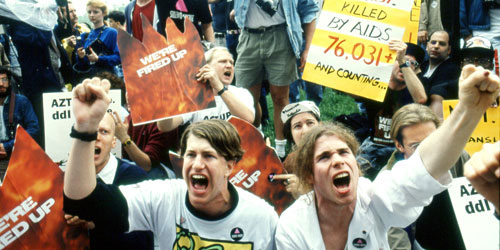
The AIDS epidemic didn't just subside. It took a fight.
David France's film debut, "How to Survive a Plague," shows not only devastation, but what was – or wasn't – done about the virus that eventually wiped out over 34 million people.
The Kalamazoo College graduate, who now lives in New York, spoke with Between The Lines about the film, which makes its local premiere during World AIDS Day Detroit at 1 p.m. Dec. 1 at the Compuware Theater.
What was it like making this film and reliving the AIDS crisis?
For me, sinking back into this time was a huge catharsis. Anybody who survived the plague years, from 1981 to 1996 – 15 long and traumatic years – has locked away major parts of their memories: the terrible losses, the personal terrors, the rages. The feelings of betrayal. All of that came back, of course.
I lost my lover to the plague. Believe me, AIDS is no easy way to die. But it was a pleasure to revisit those long-lost people in the archival footage, to see them animated again all these years later – walking, talking and laughing. Thanks to the archival footage, they remain forever young and full of life – young gay people at their very best. I had forgotten how much joy was involved in the fight back then, and how much love. That message came through clearly in the old footage, and has helped me reassess that period. A lot of good came out of the AIDS epidemic, much of it thanks to the people featured in my film.
With all this talk of HIV complacency in recent years, why is telling this story important now, three decades later, on World AIDS Day? What do you hope people who are experiencing the AIDS crisis for the first time, through the film, feel and think?
"How to Survive a Plague" shows how a few ordinary individuals, with nothing in common but a fierce will to live, changed the course of an epidemic and saved millions of lives. Fundamentally, it's a story about our capacity as human beings to tackle the insurmountable, to triumph and to prevail. That's an important and useful message on any day, for anybody confronting any challenge.
In AIDS, the challenges today remain daunting. We have not been able to stop the 55,000 new infections each year in America, most of them still among young gay men. And although some eight million people worldwide are on anti-HIV drugs, we haven't found the political will to reach the remaining 28 million, despite how cheap the medicine is. I hope people watching the film are reminded of this unfinished business and inspired to take it on and finally do something about it.
You made this movie not because you wanted to show the affliction caused by AIDS in the '80s, but because you wanted to show what can be done when a group of people stand up and fight. Why was it important to you to cast the film as such?
People think they know the story of AIDS in America, but they don't. It wasn't just a period of hideous disease and staggering death, although it certainly was that. But it was also a time of heroes and visionaries, and of revolutionary change in science and healthcare as well as in the gay community and the culture at large.
People with HIV and their advocates have left us a dazzling legacy. Through groups like ACT UP and the Treatment Action Group, which were so sometimes dismissed as reckless troublemakers in the media at the time, they even helped focus the work of Nobel Prize-winners to study the drugs that would eventually save so many lives. Somehow until now that part of history had been overlooked. I wanted to enrich the record to show not just what HIV did to our community and to the world, but what we did in response.
How did you compile such compelling archive footage? Which clip was especially difficult to attain? Any that you would've liked to include but couldn't?
At the beginning of the project, I had a memory of the bulky video cameras that were so present in those years. Activists had adopted them broadly, with somewhat overlapping motivations. Some were artists responding to and commenting on the many incomprehensible outrages defining our lives then. Others were motivated to monitor public demonstrations and document police misconduct, or to memorialize loved ones as their illness progressed. What they shared was a desire to capture the images from the plague's ravages that mainstream media was ignoring.
You notice this in one of the most startlingly dramatic moments in the film, when Tim Bailey's friends carry his open casket through the streets of New York to the headquarters of the Republican party on the rainy night before George H. W. Bush was voted out of office in 1992. They were demanding that the world acknowledge Tim's human remains and understand their grief and anger. But almost nobody noticed. You can see in the footage the activists shot that no network television camera was dispatched to the scene, and no bank of photographers greeted them in Midtown. If it weren't for the activists' cameras, the moment – and Tim's last act of civil disobedience – would have been lost.
If ACT UP hadn't fought as hard as it did during that time, pressuring drug companies to release meds to AIDS patients, how do you think that would have affected the future of HIV/AIDS? Would people still be dying in droves?
One way or another, the era of effective medication would certainly have arrived without the intercession of ACT UP and other AIDS treatment activists, just not in the same timeframe. The work the activists accomplished made it possible to identify, test and regulate the drugs quicker. As a result, the new pills were able to reach patients by mid 1996 – and within a year, hospital admission rates dropped by 80 percent. The pharmaceutical industry working in isolation might have taken another six months, or another year or maybe many years more to bring the pills to market. Thousands or more lives would have been lost, including most of the people depicted in the film.
What do you think we – we being the government, we being just the average person – learned from the AIDS epidemic?
We learned a lesson that is still being debated – that you ignore science at great peril. When we first learned about the mysterious new disease in 1981, there were 41 reported cases. If the Reagan administration had listened to epidemiologists and public health experts, rather than religious leaders and political moralists, we wouldn't have a global pandemic today. Over 34 million have died – needlessly.
How to Survive a Plague
1 p.m. Dec. 1
Compuware Theater
1 Campus Martius, Detroit
$15
surviveaplague.eventbrite.com
http://www.worldaidsdaydetroit.com











